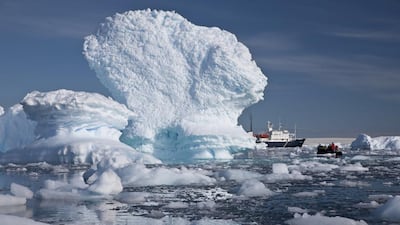According to Wikipedia, the English term “silly season” is “the period lasting for a few summer months typified by the emergence of frivolous news stories in the media”. The UAE might now be able to stake a claim to its own “silly season”.
A few days ago there was widespread coverage of "The UAE Iceberg Project", a plan to tow an iceberg all the way from Antarctica to our own East Coast in 2020 to provide a supply of pristine freshwater.
The scheme first surfaced in May last year – again in the summer – prompting a sniffy response from the Ministry of Energy, which commented on its website: "As the authority in charge of water affairs, it would like to confirm that such news is just a rumour." It went on, according to reports, to urge the public to "shun" such speculation.
Undeterred, the scheme’s promoter, the National Advisor Bureau, went public with its plans again on July 1, although this year it did not refer to the idea of "harvesting" the iceberg from Heard Island in the southern Indian Ocean. 1,600 kilometres north of Antarctica itself, Heard Island is an uninhabited territory of Australia, so perhaps the Australian Government has quietly advised the Bureau to leave its waters, and its icebergs, alone.
I’m all in favour of innovative ideas. Some will work, some won’t. Any such ideas, however, should always be greeted with a healthy dose of scepticism and cynicism. Let me offer, therefore, a few thoughts on this scheme.
Its promoters, we hear, are developing a unique technology that will “ensure zero ice melting during the transportation phase.” Since air and sea temperatures on the journey of thousands of miles from the Antarctic to the UAE’s East Coast will be well above the freezing point for freshwater for most of the journey, how do the promoters plan to prevent the iceberg, be it the part exposed or the ninety per cent of it beneath the surface of the sea, from melting?
When icebergs from offshore Greenland float south past Canada, they slowly melt. That's a natural process. Can the National Advisor Bureau prevent that during the iceberg's one-year journey?
Let us assume, for a moment, that a large remnant of the original iceberg can actually be towed all the way from Antarctica to the East Coast.
Once the first and subsequent icebergs have arrived, we are told, they will “cause a unique climatic phenomenon…[that] would attract the clouds over the Arabian Sea to the centre of the icebergs, thus creating a vortex that will cause rainfalls.”
It would be interesting to know more about the climate-modelling studies that have led to this conclusion, not least because it would be wise, one assumes, to be extremely cautious about undertaking anything that would create “a unique climatic phenomenon.” If the clouds are attracted, what kind of “vortex” will this be?
It sounds potentially rather worrying. Major, unseasonal storms? An impact on the normal behaviour of the Indian Ocean monsoon? Would any disruption of normal weather patterns be purely temporary, or would there be longer-term side-effects with potentially devastating results not just along the East Coast but much further afield?
One wonders how much thought the promoters may have given to such topics. Meddling with the weather, apart from projects that are limited to relatively small areas, such as the UAE's successful cloud-seeding activities to generate rainfall, is, surely, a rather dangerous game.
There are other issues, too. The UAE's East Coast lies on one of the world's major shipping lanes, while Fujairah is the world's second largest oil bunkering port. Anyone who has seen Titanic might well ask if there would be any dangers to shipping. How far offshore would the iceberg be anchored – or would it simply be towed until it grounded on the shallowing seabed? As it became smaller, it would rise, so how would movement be prevented? Should we worry? I would.
The water around the iceberg would, of course, be cooled. What would be the impact on marine life and, therefore, on the fishing industry? As warmer and cooler waters mixed, what effect would this have on prevailing currents?
Some of the statements issued by the National Advisor Bureau seem to suggest, moreover, that some of their research has been lacking in depth.
For instance, they say that the project “would place the UAE on the glacial tourism map…saving iceberg enthusiasts the trouble of travelling to the North and South Poles”. There are, of course, no icebergs at either Pole, although the North Pole is located at the centre of a huge ice-sheet.
Icebergs can, though, can be seen off the southern tip of Greenland, whose northern tip, over 2,500 kilometres away, is still a long way from the North Pole. An indication of better knowledge of global geography might, just might, enable one to take the Bureau’s statements a little more seriously.
In the meantime, I'm starting work on the outline of a film proposal, convinced that there is scope here for a blockbuster disaster movie. That, in my cynical view, is where this idea currently belongs – firmly in the realm of fiction.
Peter Hellyer is a consultant specialising in the UAE’s history and culture


